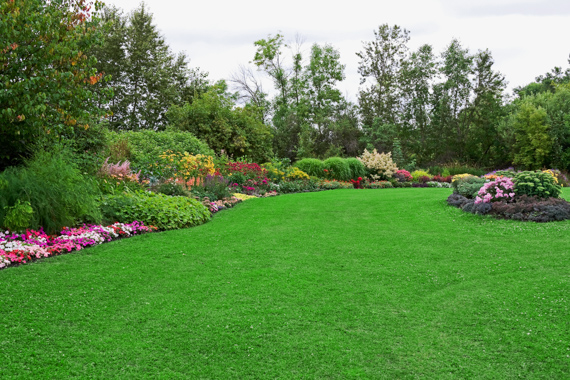NJ Drainage Contractor
Guaranteed Drainage Solutions
Spring rains are no match for a competently designed storm water drainage system.
Bobcats for Hire is prepared to solve your property's drainage problems for good. We will carefully evaluate your site conditions to design and install an appropriate drainage system using accepted engineering practices to your location that will meet the needs of your site while complying with local stormwater laws. Thousands of Homeowners have benefited from our expertise and solved their drainage problems for good.
Design
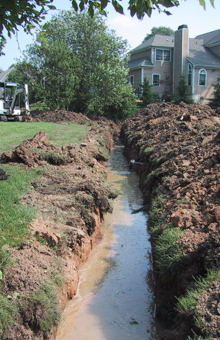
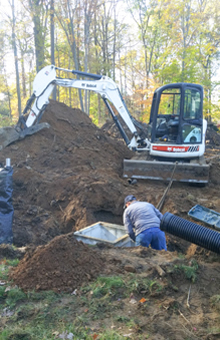
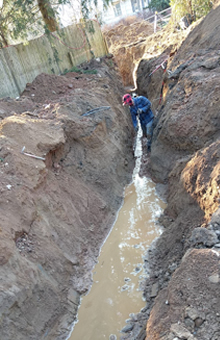
Your Perfect Lawn
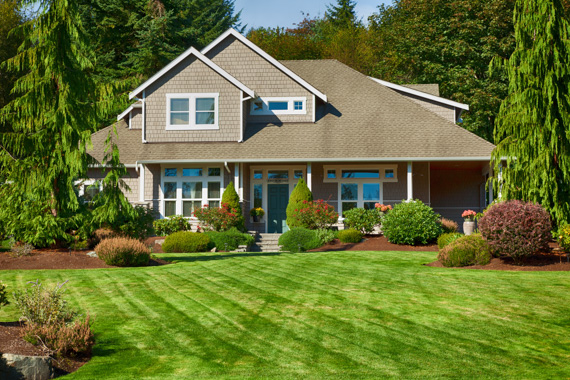
Our projects begin with a thorough assessment of the needs for the homeowner and site. Grading and drainage are important details to get right before expensive landscaping, patios, pools, or other items are installed. All too often, homeowners opt for "decorative" items to be installed prior to "functional" items. The result of this mistake is added expense or property damage that can easily be avoided with proper foresight and planning. Have a pro design and install your grading and back yard water remediation system today!
Licensed and Insured
Our company is licensed in the State of New Jersey, and we also carry full liability insurance for both liability and workman's compensation. We are prepared to secure permits for your grading project when required, and will ensure that your project is first class in performance and will not adversely affect an adjoining property. We bring value to our customers by providing a unique combination of 33 years of project management experience along with the engineering knowledge necessary to ensure that your project is designed and installed correctly. Each one of our projects is properly supervised at all times, which ensures our customers top quality installations.Engineer on Staff
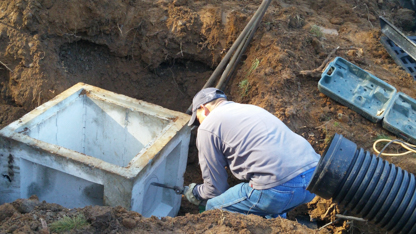
Accepted Engineering Practices will be used in all of our drainage designs
33 Years Experience
Experienced in all phases of drainage design and installation ensures both a unique solution to your site, and also a sucessfull, lasting improvement to your home.
Data gathering ensures effective installations
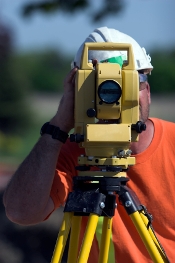
Our systems are constructed using rigid PVC pipe, wide roll protective filter fabric, and plenty of 2 ½" crushed stone for drainage. We will shoot elevations and calculate both flow rates and pipe sizing to ensure that your system will work as intended. Your project designed by our engineer and the installation is also carefullly monitored to ensure that it is installed to our standards. This care in installation ensures that your underground drainage system is going to function as intended for many years into the future. Our equipment uses wide rubber tracks that operate excellent in swampy, wet areas which are usually found in drainage applications. These wide track machines enable our company to install a professional drainage system in much less time, with much more crushed stone, and also with much less damage to existing lawns than conventional rubber tire machines. Because larger French Drain systems are constructed below ground and may require as much as fifty to seventy-five tons of stone, it is imperative to hire a contractor who understands the nature and limitations of water flow and is using dedicated track equipment. This ensures that your project will be designed correctly and will receive the required, difficult to move materials to function as intended. Our articulated excavators allow for digging in compact areas and also against a building which is usually needed when addressing a leaky basement.
French Drains
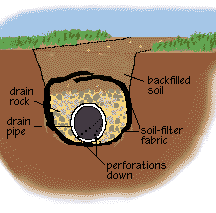
The purpose of a French Drainage System is to carry unwanted free standing water away from a building, such as your home. French drains are commonly installed near the perimeter of a building at the lowest point or anywhere where standing water is found. The system may terminate at any point where the water will not drain back toward the house. The best approach is to connect to a city storm drain, where possible, to totally remove the water from the property. A second best solution would be to run the water out to the street or to a dry well. French drains can be shallow or deep drainage systems depending on soil type and grade changes. However, as with your plumbing waste drainage, French drains operate on the principle of gravity. The drain must slope downward. The minimum recommended slope is 1/4 inch per foot. If the landscape grade runs upward along the French drain path you will have to dig deeper to maintain a downward slope. There are many variables that affect how individual houses develop water problems. Often it is a combination of factors that develop over time. French drains work by curing a symptom, not the cause. They extract the water collected in the drainage pipes to an outside location away from the area intended to be kept dry. It is always more beneficial to divert water on the outside of a foundation wall before it ever has an opportunity to penetrate the foundation. This method has several advantages which include reducing or eliminating mold, protecting the foundation from excess moisture, and also (usually), the benefit of a gravity only system.
Exterior Basement Waterproofing & Grading improvements
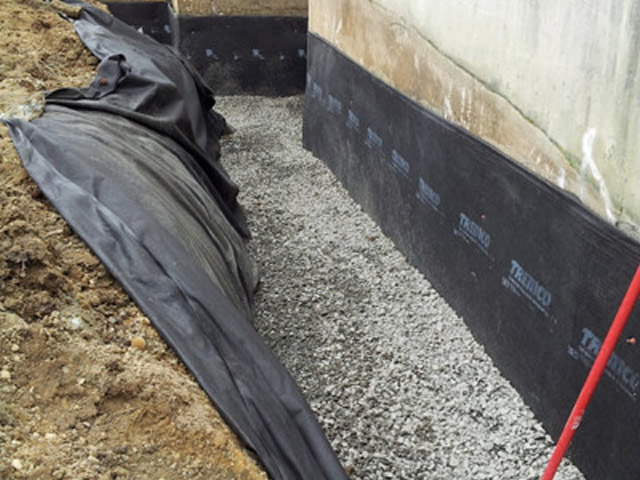 Beware of slick salespeople that suggest an inside French Drain to cure your basement water problems. It is always more beneficial to divert unwanted water before it has a chance to penetrate your foundation walls, allowing it to flow away via gravity instead of using an electric pump to remove the water from your basement sump pit. "Inside French Drains" encourage the water to pour through your foundation walls where it will collect in a sump pit. The only thing between you and a flooded basement is that small electric pump and a steady supply of electricity during the storm. Keep in mind that power outages most frequently occur during a storm. Also, an inside French drain does not "waterproof" your basement, but instead collects the water and dampness inside your basement to be pumped out with an electric pump. Both water and dampness remain inside your basement with an "inside" French drain.
Beware of slick salespeople that suggest an inside French Drain to cure your basement water problems. It is always more beneficial to divert unwanted water before it has a chance to penetrate your foundation walls, allowing it to flow away via gravity instead of using an electric pump to remove the water from your basement sump pit. "Inside French Drains" encourage the water to pour through your foundation walls where it will collect in a sump pit. The only thing between you and a flooded basement is that small electric pump and a steady supply of electricity during the storm. Keep in mind that power outages most frequently occur during a storm. Also, an inside French drain does not "waterproof" your basement, but instead collects the water and dampness inside your basement to be pumped out with an electric pump. Both water and dampness remain inside your basement with an "inside" French drain.
First Class Basement Foundation Drain
The foundation drain and waterproof membrane shown to the right will ensure that this basement will be dry and mold free over time. The exterior membrane prevents the foundation walls from contact with saturated soil, and the foundation drain ensures that water collected has a gravity path to be discharged away from the structure.Call today to arrange a thourough site evaluation and remediation proposal that is a custome solution to your home's water and drainage problems. You'll be glad that you did.
New Jersey Yard Drainage Contractor
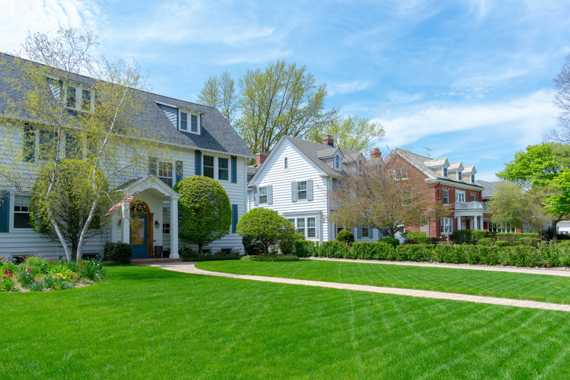 This home in New Jersey had a saturated backyard even during the summer months. Mosquitoes were a major problem due to this persistently saturated condition. Following numerous quotes from area landscapers who simply wanted to add top soil, the homeowner called upon Bobcats for Hire to solve the water problems plaguing their property. A comprehensive design was proposed that included a combination of French drain and also connection of leader drains. This entire system runs by gravity and never needs a pump or electricity! Professional grade filter fabric is being used above to protect the trenches from sediment buildup. This fabric is shipped on a fifteen foot wide roll to ensure that the new drain is properly protected. The fabric allows water to flow through to the drain, but keeps all sediment from contaminating the stone. Filter fabric is the best way to ensure that your drain will perform for many years to come. Upon excavation, we found a large contributing factor to the problem which could only be solved using our gravity based system of drainage. The neighbor's sump pump and roof drainage water were being surreptitiously directed to the border of the properties with nowhere to go except in the lawn. (See pictures to the right) A long trench had been excavated approximately four feet deep and diagonally across the property so that the water could be routed to a city storm sewer instead of this customer's backyard. The drain is also protected with Typar filter fabric and backfilled with 2 ½" crushed stone. Two pipes are used as conduit for the water. The lower pipe at the bottom of the trench is a four inch perforated PVC pipe used to carry the seeping water to the storm basin. The visible pipe is also PVC, but solid to carry away the water intruding from the neighboring property directly to the storm sewer. The entire trench is then wrapped in the protective fabric where lawn will be replanted. The end result is a dry back yard with the added benefit that the basement sump pump now runs much less frequently than it did prior to the installation of the drainage system in the backyard.
This home in New Jersey had a saturated backyard even during the summer months. Mosquitoes were a major problem due to this persistently saturated condition. Following numerous quotes from area landscapers who simply wanted to add top soil, the homeowner called upon Bobcats for Hire to solve the water problems plaguing their property. A comprehensive design was proposed that included a combination of French drain and also connection of leader drains. This entire system runs by gravity and never needs a pump or electricity! Professional grade filter fabric is being used above to protect the trenches from sediment buildup. This fabric is shipped on a fifteen foot wide roll to ensure that the new drain is properly protected. The fabric allows water to flow through to the drain, but keeps all sediment from contaminating the stone. Filter fabric is the best way to ensure that your drain will perform for many years to come. Upon excavation, we found a large contributing factor to the problem which could only be solved using our gravity based system of drainage. The neighbor's sump pump and roof drainage water were being surreptitiously directed to the border of the properties with nowhere to go except in the lawn. (See pictures to the right) A long trench had been excavated approximately four feet deep and diagonally across the property so that the water could be routed to a city storm sewer instead of this customer's backyard. The drain is also protected with Typar filter fabric and backfilled with 2 ½" crushed stone. Two pipes are used as conduit for the water. The lower pipe at the bottom of the trench is a four inch perforated PVC pipe used to carry the seeping water to the storm basin. The visible pipe is also PVC, but solid to carry away the water intruding from the neighboring property directly to the storm sewer. The entire trench is then wrapped in the protective fabric where lawn will be replanted. The end result is a dry back yard with the added benefit that the basement sump pump now runs much less frequently than it did prior to the installation of the drainage system in the backyard.
Seepage Pits are required by many townships
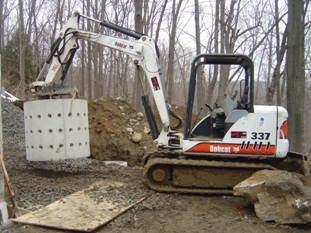
Professional Installation for a First Class Project
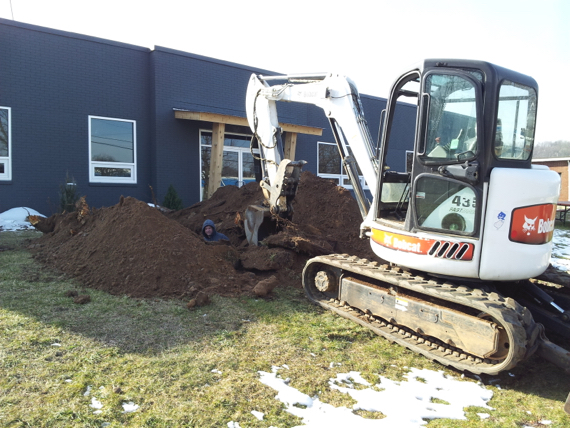
Yard Drainage Solutions
Installation: Installing a French drain requires planning and is a labor intensive project. Obstacles, however, can make the project costly and time consuming. These include: Decks, concrete walkways, driveways, tree roots, boulders, and underground utilities. 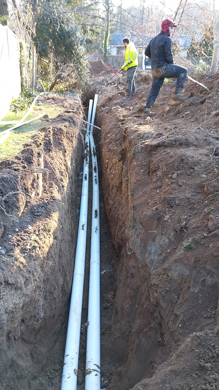 If you build a house, be sure to ask the builder to include inside and especially outside French drains on your new house. They may not seem important now, but as your house ages, water incursions can change over time, and a cheap installation now may relieve expensive headaches later.
If you build a house, be sure to ask the builder to include inside and especially outside French drains on your new house. They may not seem important now, but as your house ages, water incursions can change over time, and a cheap installation now may relieve expensive headaches later. 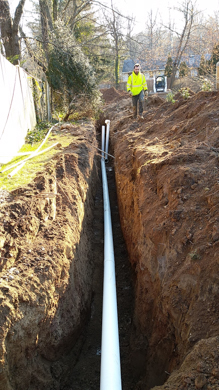 During construction, the cost of a French drain is negligible. Spring for it. Demand it! French drains are commonly installed near the perimeter of a building at the lowest point or anywhere where standing water is found. The system may terminate at any point where the water will not drain back toward the house. The best approach is to connect to a city storm drain, where possible, to totally remove the water from the property. A second best solution would be to run the water out to the street or to a dry well.
During construction, the cost of a French drain is negligible. Spring for it. Demand it! French drains are commonly installed near the perimeter of a building at the lowest point or anywhere where standing water is found. The system may terminate at any point where the water will not drain back toward the house. The best approach is to connect to a city storm drain, where possible, to totally remove the water from the property. A second best solution would be to run the water out to the street or to a dry well. 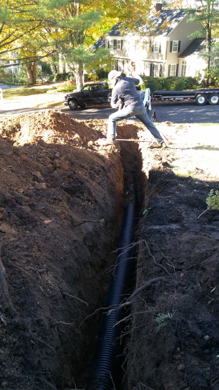 French drains can be shallow or deep drainage systems depending on soil type and grade changes. However, as with your plumbing waste drainage, French drains operate on the principle of gravity. The drain must slope downward. The minimum recommended slope is 1/4 inch per foot. If the landscape grade runs upward along the French drain path you will have to dig deeper to maintain a downward slope.
French drains can be shallow or deep drainage systems depending on soil type and grade changes. However, as with your plumbing waste drainage, French drains operate on the principle of gravity. The drain must slope downward. The minimum recommended slope is 1/4 inch per foot. If the landscape grade runs upward along the French drain path you will have to dig deeper to maintain a downward slope. 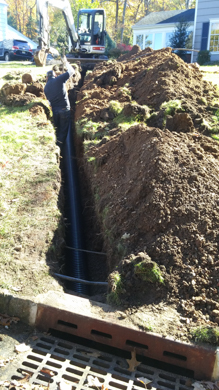 There are many variables that affect how individual houses develop water problems. Often it is a combination of factors that develop over time. French drains work by curing a symptom, not the cause. They extract the water collected in the drainage pipes to an outside location away from the area intended to be kept dry. It is always more beneficial to divert water on the outside of a foundation wall before it ever has an opportunity to penetrate the foundation. This method has several advantages which include reducing or eliminating mold, protecting the foundation from excess moisture, and also (usually), the benefit of a gravity only system.
There are many variables that affect how individual houses develop water problems. Often it is a combination of factors that develop over time. French drains work by curing a symptom, not the cause. They extract the water collected in the drainage pipes to an outside location away from the area intended to be kept dry. It is always more beneficial to divert water on the outside of a foundation wall before it ever has an opportunity to penetrate the foundation. This method has several advantages which include reducing or eliminating mold, protecting the foundation from excess moisture, and also (usually), the benefit of a gravity only system.
Grading and Drainage installation
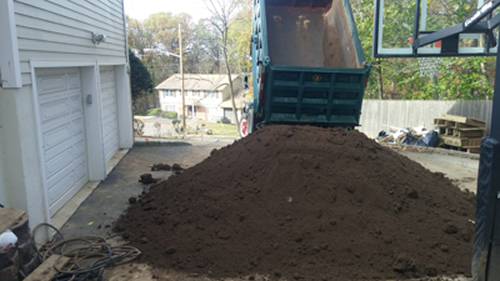
Bobcats for Hire is prepared to install superior drainage to your property while also grading your lawn to direct water away from your home and landscape areas. Our projects begin with a thorough assessment of the needs for the homeowner and site. Grading and drainage are important details to get right before expensive landscaping, patios, pools, or other items are installed. All too often, homeowners opt for "decorative" items to be installed prior to "functional" items. The result of this folly is added expense that can easily be avoided with proper foresight and planning. Have a pro design and install your grading and back yard water remediation system today! Our company is licensed in the State of New Jersey, and we also carry full liability insurance for both liability and workman's compensation. We are prepared to secure permits for your grading project when required, and will ensure that your project does not adversely affect an adjoining property.
Bobcats for hire is prepared to plan the needed improvements to your property for a long lasting and cost effective solution. Our areas of involvement also include excavating, grading, drainage improvements, dry well installations, and landscaping for the long term enjoyment of your property. Call today for that professional look to your home or business. You will save by hiring a reputable company that is equipped to handle the needs of your project!
Your Perfect Lawn Awaits!
